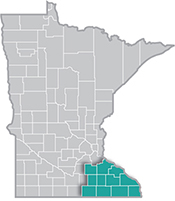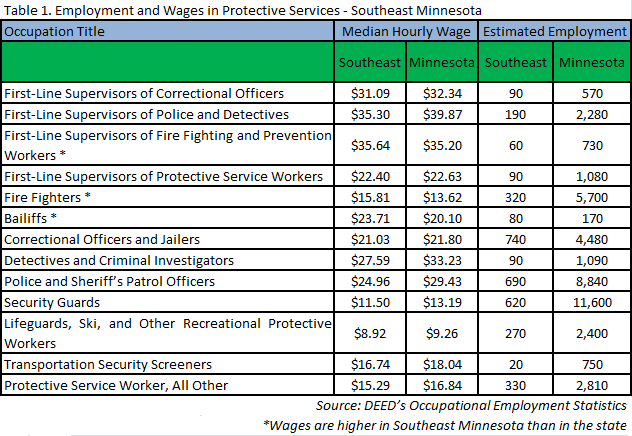 Southeast Minnesota is a health care and agricultural powerhouse. The region is home to the renowned Mayo Clinic and some of the world's most recognized food companies and brands.
Southeast Minnesota is a health care and agricultural powerhouse. The region is home to the renowned Mayo Clinic and some of the world's most recognized food companies and brands.
Advanced manufacturing is especially strong here, with machinery, chemicals, and electronics among the top products.
Want the freshest data delivered by email? Subscribe to our regional newsletters.
2/27/2015 2:23:55 PM
There are currently more than 3,500 workers in the protective services field in Southeast Minnesota.
More than half of them work as correctional officers and jailers, police and sheriff's patrol officers, and security guards.
The region has slightly smaller numbers of other protective services workers such as firefighters, lifeguards, bailiffs, and transportation security screeners.
Generally, jobs within the protective services field are relatively high paying with median hourly wages ranging from $15 - $35. Lifeguards and security guards earn the field's lowest wages at less than $11.50 per hour at the median. The field's highest wages are in supervisory positions for firefighting and prevention workers ($35.64), police and detectives ($35.30), and correctional officers ($31.09).
Workers can often obtain supervisory positions in the protective services field through work experience, without additional educational attainment. More advanced occupations in the field, however, such as detective and criminal investigator positions, usually require post-secondary education, certificates, or licenses.
Our Occupational Projections data tool shows there will be nearly 1,500 total openings in the protective services field in Southeast Minnesota between 2012 and 2022. During this time, the nature of these openings will likely change perhaps resulting in additional education and training requirements, as technology plays an increasing role in the field.
Marshal Ogren, a detective specializing in digital forensics for a state-level protective service department, identifies two reasons for the increasing importance of technology in the protective services field.
First, technology is playing a more significant role in almost every crime, including the increase in cyber crime. One recent trend is people documenting crimes on devices like cell phones, and then sharing the videos on websites like YouTube and Facebook, subsequently implicating those involved.
Second, protective services departments are relying more on technology to investigate and solve crimes. Ogren, for example, has advanced software on a specialized computer that allows him to analyze cell phones and other evidence while investigating crimes committed in his jurisdiction. He believes that more advanced training and education will be required to keep up with technological advances in both criminal behavior and investigative techniques.
The need for protective services employees to serve residents of Southeast Minnesota will never disappear. Formal training on the use of advancing technology is rapidly becoming a prerequisite as both crime and crime fighting rely more on technology. As a result, it is possible that the current number of projected openings is underestimated because jobs that do not currently exist may be created, and that wages will increase due to advanced education and training requirements.

Contact Mark Schultz.